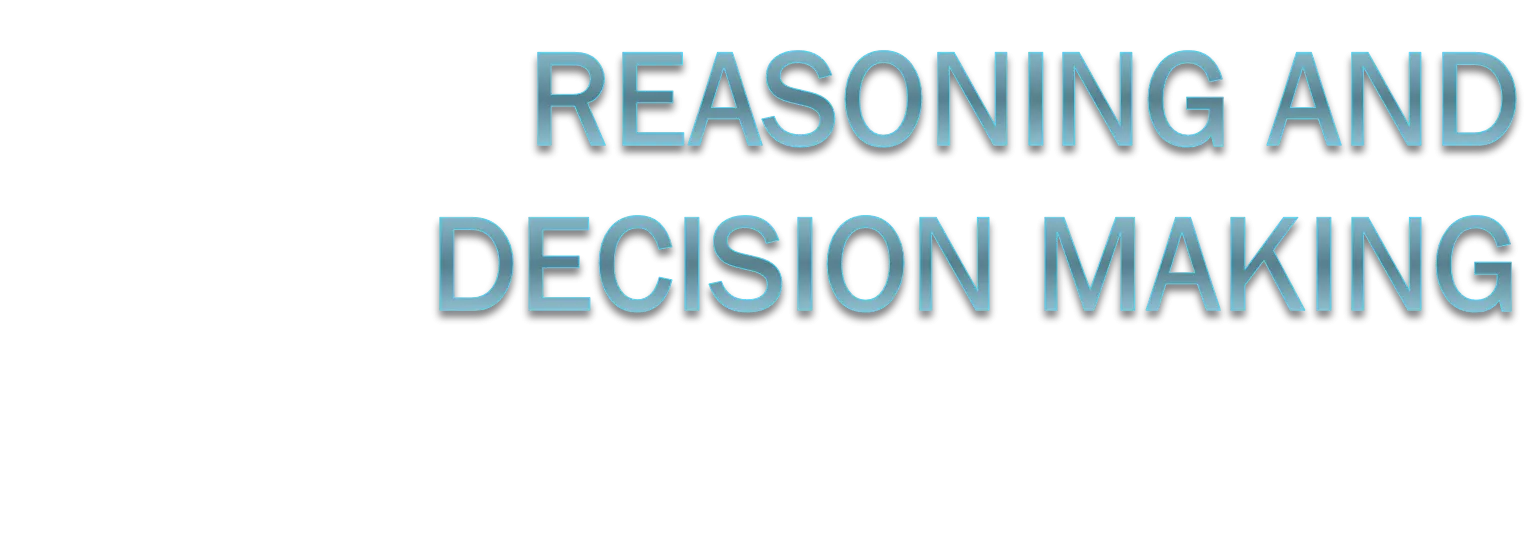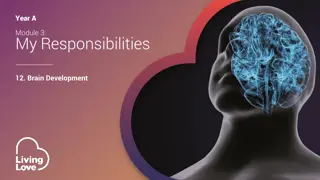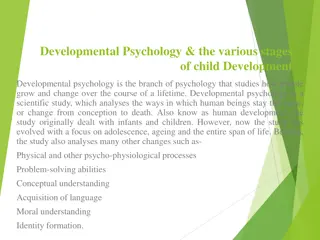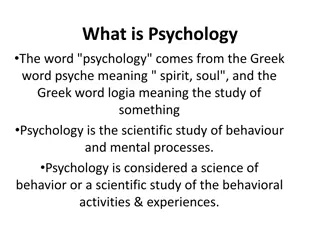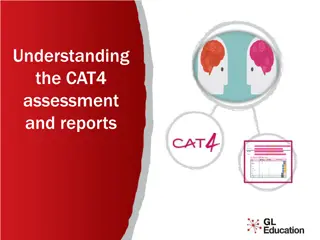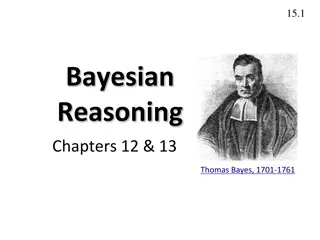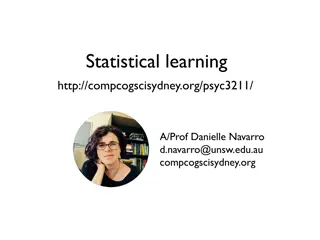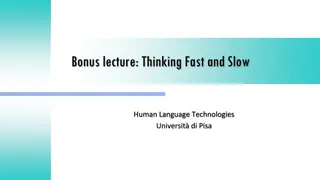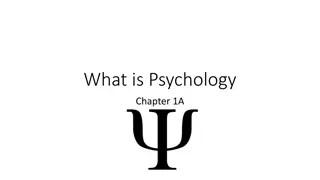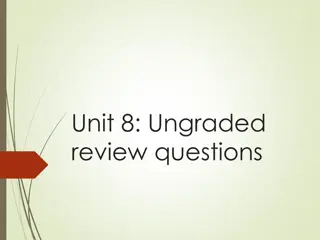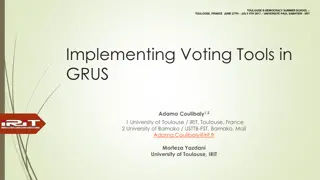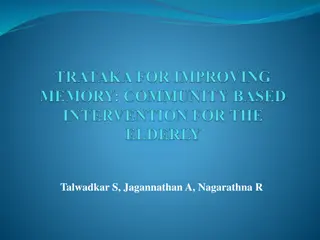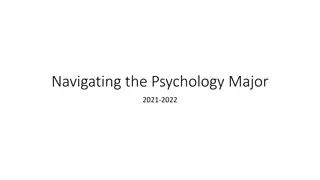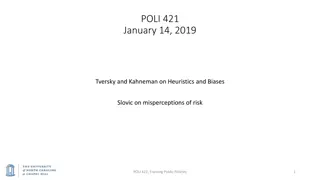Reasoning and Decision-Making in Cognitive Psychology
Exploring the intricacies of reasoning, decision-making, and logic in cognitive psychology, this content delves into how humans process information, make choices based on heuristics, and struggle with understanding probability. The challenges in conditional reasoning are highlighted through examples, showcasing common pitfalls in logical thinking. By examining different tests and scenarios, the content aims to enhance comprehension of cognitive processes related to decision-making.
Download Presentation

Please find below an Image/Link to download the presentation.
The content on the website is provided AS IS for your information and personal use only. It may not be sold, licensed, or shared on other websites without obtaining consent from the author.If you encounter any issues during the download, it is possible that the publisher has removed the file from their server.
You are allowed to download the files provided on this website for personal or commercial use, subject to the condition that they are used lawfully. All files are the property of their respective owners.
The content on the website is provided AS IS for your information and personal use only. It may not be sold, licensed, or shared on other websites without obtaining consent from the author.
E N D
Presentation Transcript
Langston, PSY 4040 Cognitive Psychology Notes 13 REASONING AND REASONING AND DECISION MAKING DECISION MAKING
Where We Are We re continuing our tour of higher cognition. We ve covered: Categorization Language Structure Language Meaning And we continue with: Reasoning/Decision making Human factors
Plan of Attack We ll look at three areas: Logic. We ve already seen that the rules of logic don t account for performance on a variety of cognitive tasks. You will not be surprised to know that people s reasoning about logic is also faulty. Heuristics: What short-cuts do people take and how do those short-cuts affect decisions? Probability: People are notoriously bad at understanding probability. We ll look at that and try to understand why.
Logic We ll consider conditional reasoning here. You re presented with a rule in the form of an if-then statement. You want to test this rule to see if it is supported by the situation.
Logic People tend to be pretty bad at these problems. Try this one: If there s an even number on one side, then there s a vowel on the other. Which should you flip to check? A B 1 2
Logic The correct answer is 2 and B. In a test of similar problems, people pick: 2: 33% 2 and A: 46% 2 and B: 4% A B 1 2
Logic How do you know what the correct answer should be? Consider this problem: If the red light appears, then the engine is overheating. Two valid tests: Modus ponens: The red light appeared. Therefore the engine is overheating. Modus tollens: The engine is not overheating. Therefore, the red light must not have appeared.
Logic How do you know what the correct answer should be? Consider this problem: If the red light appears, then the engine is overheating. Two invalid tests: Denying the antecedent: The red light did not appear. Therefore, the engine is not overheating. Affirming the consequent: The engine is overheating. Therefore, the red light appeared.
Logic In general terms: If p then q: Modus ponens: p. Therefore q. Modus tollens: not q. Therefore, not p. Denying the antecedent: not p. Therefore, not q. Affirming the consequent: q. Therefore, p.
Logic If you look closely at the invalid ones, they assume a relationship that is not stated in the hypothesis. Affirming the consequent: If p then q. Present q, must be p. That s really saying If p then q and if q then p. Denying the antecedent: If p then q. Present not p, must not be q. That s really saying the only way to get q is p, and I didn t claim that in the hypothesis. I never said If not p then not q.
Logic The interesting cognitive question is: Why are people so bad at this? Illicit conversion. People tend to reverse the order of the terms or make it into a biconditional problem. They read if p then q as if p then q and if q then p. However, the order matters. Except for writing things down and being careful, there s not a tip to avoid this kind of confusion.
Logic The interesting cognitive question is: Why are people so bad at this? Illicit conversion. Consider this: If you smoke, then you will get cancer. Valid: I smoke and didn t get cancer, so it s wrong. Invalid: I got cancer and I never smoked, so it s wrong. If you turned it around to: If cancer, then smoked, the invalid test becomes valid.
Logic The interesting cognitive question is: Why are people so bad at this? Illicit conversion. Tangent: This is related to one of the themes of the class. People make mistakes, and a lot of those mistakes are relatively easy to predict. For example, if you exceed the capacity of STM, you will not remember everything you are trying to remember. This is one of those cases. Use this class to gain insight into how things might go wrong, and then make them go right.
Logic The interesting cognitive question is: Why are people so bad at this? Confirmation bias. People have a tendency to confirm what they believe to be true rather than to try to disconfirm. Since q is in the hypothesis, when people see q, they think that s the one to pick for the test. That s part of what s going on in the card sorting task. Confirmation bias can also interact with other parts of people s reasoning problems to reinforce stereotypes.
Logic Another interesting cognitive question is: Why are people so good at some conditional reasoning problems? If you re under 21 then you should not be drinking alcohol. You know either the age or the drink. Which two should you pick to test the rule? 18 coke 43 beer
Logic Most people guess 18 and beer with no problem. Why? One hypothesis is contextual support. Another is that you have evolved an ability to detect cheaters and are good at permission situations. 18 coke 43 beer
Logic The Wason selection CogLab examined this, let s turn to that now
Heuristics There are two ways to solve problems. Algorithmic: Go through each step in the process. Multiply 365 by 48. This is usually impractical, and people rarely do it. Heuristics: Rough and ready rules that get the answer most of the time. We ll look at heuristics in thinking.
Heuristics Representativeness heuristic: Judge how likely something is based on how representative it is. Which is a more likely outcome of flipping a fair coin six times in a row: H H H T T T H H T H T T Most people pick the second because it looks more random. Of course, they re equal.
Heuristics Some implications of representativeness: Lottery play. Does 1 2 3 4 5 6 seem like a good set of numbers to play? Most people think it s a bad choice because it s so unlikely. But, every set of numbers is equally likely. If you re thinking about playing, ask yourself if you would play 1 2 3 4 5 6. If the answer is no, you understand the odds and shouldn t play. But, 1 2 3 4 5 6 is actually very representative of numbers other people won t play, which means a lot of people do play it, and that makes it a bad choice (you ll split the pot with more people, decreasing the expected value of the lottery payoff). Numbers > 31 are also bad due to representativeness.
Heuristics Some implications of representativeness: Stereotypes. If something you see is representative of a stereotype you are more likely to notice it and add it as evidence (especially with confirmation bias).
Heuristics Availability heuristic. When you decide how likely something is, think of an example, and base your estimate on how hard it is to do that. Are there more words that begin with a k or have a k as the third letter?
Heuristics Another example: Pick a number from 1-9. Subtract 5, multiply by 3, and square it. If more than one digit, add them together (e.g., 64 = 6 + 4 = 10 = 1 + 0 = 1) If your number is less than 5, add 5. Otherwise, subtract 4. Multiply by 2 and subtract 6. Map the digit to the letter of the alphabet it goes with (1 = A, 2 = B ) Pick a country that begins with that letter. Take the second letter of the country and pick an animal name that begins with that letter. What color is that animal?
Heuristics There are no gray elephants in Denmark. Availability: Denmark and elephant. Representativeness: Gray.
Heuristics Availability is influenced by a lot of factors that should be unsurprising to people finishing a cognitive class: Frequency: More frequent = more available. Familiarity: More familiar = more available. Vividness: More vivid = more available. Recency: More recent = more available. How could these influence people s thinking that driving is safer than flying?
Heuristics Simulation heuristic. Ease of simulation influences people s judgments. Two men are on flights that leave at the same time and are riding in the same car. They arrive 1/2 hour late. Mr. Crane s flight left on time, but Mr. Tee s flight was delayed and only left five minutes ago. Who is more annoyed at missing their flight?
Heuristics Influences on simulation: Undoing. People usually file down unusual details to make the sequence of events more typical (downhill change) rather than add details (uphill change) when simulating events. George decides to leave work early. When he gets to the parking lot he has a flat tire and stops to change it. Still in a good mood, he decides to take the scenic drive home even though that will take a little longer. He stops at the store on the way. As he is nearing his house, his car is hit by a drunk driver running a red light and he is killed. If only
Heuristics Influences on simulation: Hindsight bias. Once you know the outcome, it s easier to simulate how that outcome could have happened, and that makes the outcome seem more likely. It can also make you reinterpret how you felt about the probability of the outcome before it happened. Rodgers stuck it to each of those 23 NFL teams that ignored him on the longest day of his life: April 23, 2005, when the Packers chose him with the 24th pick of the draft. He says it turned out to be the best day of his life, but sorry, here s guessing Feb. 6, 2011 -- when Rodgers Packers beat the Pittsburgh Steelers -- just moved ahead. ESPN.com 2/7/11 In football, should a team go for it on fourth down? In Deal or No Deal, should someone take the deal?
Heuristics John S. is a supervisor in a local manufacturing firm. John is responsible for promoting the employees in his department. In the past he has been accused of being against equal rights and opportunities for women. There are 1 male and 9 females in his department who are potential candidates for promotion. John decides to give these employees a written examination to help with his decision. John grades these exams himself, and reports that the highest mark was obtained by a man, whom he promotes. How suspicious are you that John s grading of the exam was unfair? (Write 1-100, with 100 being very suspicious).
Heuristics John S. is a supervisor in a local manufacturing firm. John is responsible for promoting the employees in his department. In the past he has been accused of being against equal rights and opportunities for women. There are 10 male and 90 females in his department who are potential candidates for promotion. John decides to give these employees a written examination to help with his decision. John grades these exams himself, and reports that the highest mark was obtained by a man, whom he promotes. How suspicious are you that John s grading of the exam was unfair? (Write 1-100, with 100 being very suspicious).
Heuristics Ease of simulation makes the first one sound more suspicious.
Additional Influences Anchoring and adjustment. People tend to start from the first part of the problem (the anchor) and then adjust from there. If you start with a high anchor people tend to go high and vice versa.
Additional Influences Anchoring and adjustment examples:
Additional Influences Anchoring and adjustment examples: One half multiply 8 X 7 X 6 X 5 X 4 X 3 X 2 X 1
Additional Influences Anchoring and adjustment examples: One half multiply 1 X 2 X 3 X 4 X 5 X 6 X 7 X 8
Additional Influences Anchoring and adjustment examples: One half multiply 8 X 7 X 6 X 5 X 4 X 3 X 2 X 1 One half multiply 1 X 2 X 3 X 4 X 5 X 6 X 7 X 8 The median for the first problem was 2250, for the second it was 512 (Tversky & Kahneman, 1974). The answer is 40320.
Additional Influences Anchoring and adjustment examples: Two lotteries: 50% red marbles in a bag, 50% white. You try to draw a red marble. 90% red marbles, 10% white. You try to draw 7 red marbles in a row. Which gives the best chance of winning? They re about equal. Why do people prefer one over the other?
Additional Influences Set/Fixedness. Mental set: A biased way of responding based on previous experience and an understanding of the task demands. Fixedness: Getting stuck in a particular solution and not being able to get out of it. Functional fixedness. Thinking of something s typical use and not seeing how else it could apply.
Additional Influences Set/Fixedness examples. Set. Connect the nine dots below by drawing four straight lines (you can t pick up your pen):
Additional Influences Set/Fixedness examples. Fixedness. Jug problems. You can fill a jug all the way up and dump it all the way out or all the way into another jug. Solve these: 1: Fill B, pour it into A, pour it into C twice = 100 left Problem: 1 2 3 4 Jug A: 21 14 18 15 Jug B: 127 46 43 39 Jug C: 3 5 10 3 Target: 100 22 5 18
Additional Influences Set/Fixedness examples. Functional fixedness. You re in a plane crash in the desert. You have the following items: A parachute, a map, a compass, and a pocket mirror. What is your most valuable asset?
Additional Influences Set/Fixedness examples. Set. Connect the nine dots below by drawing four straight lines: People don t realize that the answer requires literally thinking outside the box.
Additional Influences Set/Fixedness examples. Fixedness. Solve these jug problems: The trick is that you can do the last one in an easier way, but once you get in a groove you just keep going. Problem: 1 2 3 4 Jug A: 21 14 18 15 Jug B: 127 46 43 39 Jug C: 3 5 10 3 Target: 100 22 5 18
Additional Influences Set/Fixedness examples. Functional fixedness. You re in a plane crash in the desert. You have the following items: A parachute, a map, a compass, and a pocket mirror. What is your most valuable asset? Your mirror is the most important to signal for help. You have to get past the usual use of a mirror to see its value.
Additional Influences Confidence. Generally people are more confident in their answers to general knowledge questions than they are correct. The more confident, the more they are overestimating their ability. Hirsute probably means either really hairy or habitually late. Pick one and rate your confidence.
Additional Influences Belief. Once people state a belief it s hard to get them to change their mind, even if you tell them that the facts upon which the belief was based are made up. It s better to be in the back of an airplane in a crash. Why?
Additional Influences Belief. Once people state a belief it s hard to get them to change their mind, even if you tell them that the facts upon which the belief was based are made up. It s better to be in the back of an airplane in a crash. Why? It really doesn t matter, but once you make up the reasons it can be hard to let it go.
Additional Influences Framing. How you frame the question impacts how people reason about it. Framing as gains increases people s choices of lotteries. On a scale of 1 - 7 (where one is not dangerous), rate how dangerous each is: 10% of the people who eat a new kind of sushi will die. 90% of the people who eat a new kind of sushi will live.
Additional Influences Framing. How you frame the question impacts how people reason about it. Framing as gains increases people s choices of lotteries. On a scale of 1 - 7 (where one is not dangerous), rate how dangerous each is: 10% of the people who eat a new kind of sushi will die. 90% of the people who eat a new kind of sushi will live. People think the live one is safer, but they re the same.
Additional Influences Let s look at the CogLab exercise on decision making
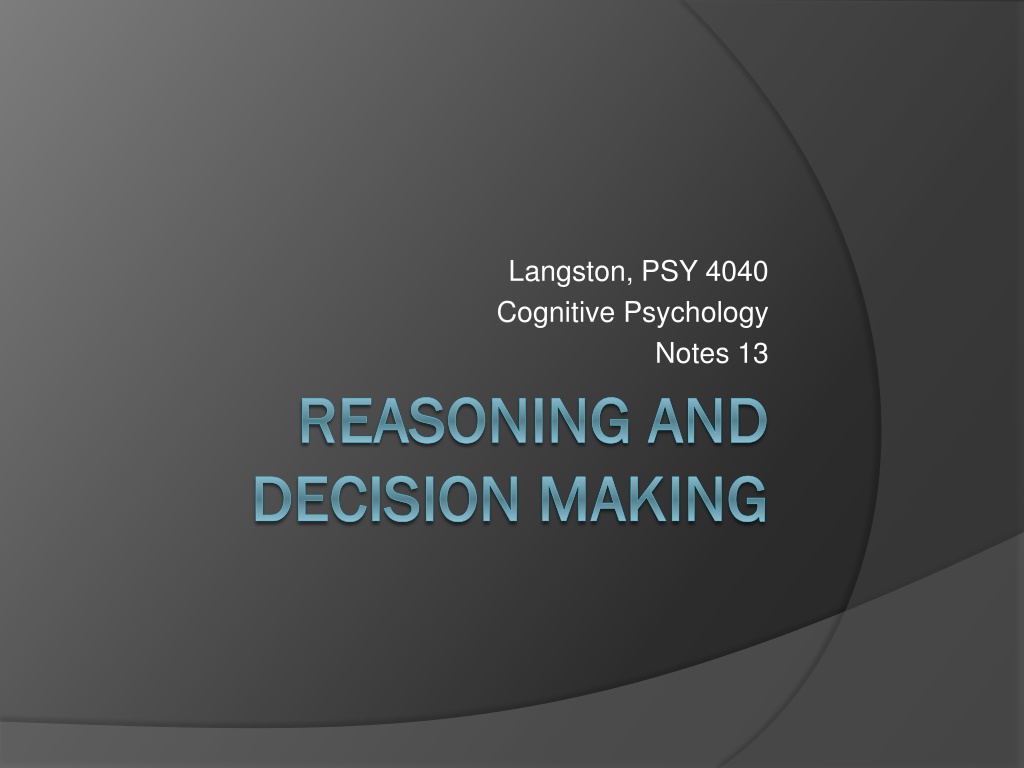
 undefined
undefined

